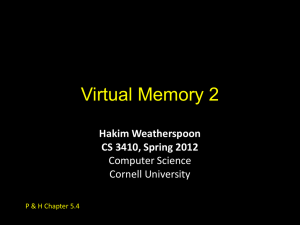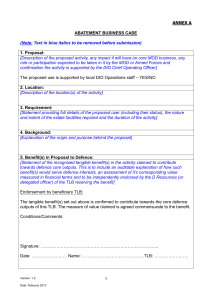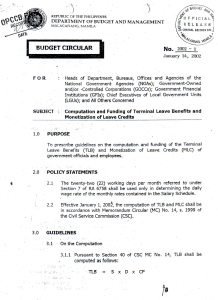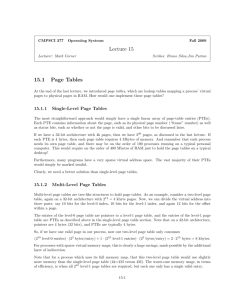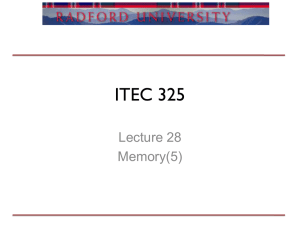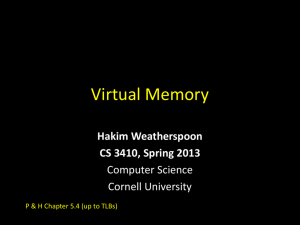Virtual Memory 2 - Computer Science
advertisement
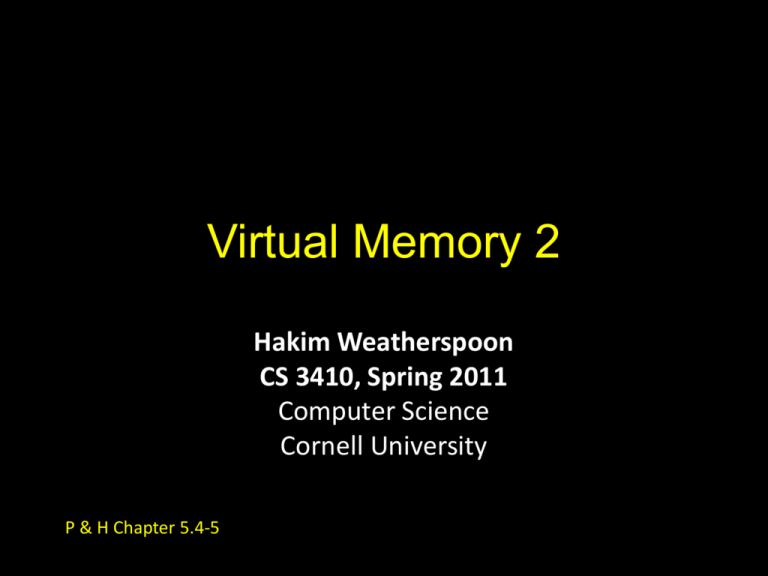
Virtual Memory 2
Hakim Weatherspoon
CS 3410, Spring 2011
Computer Science
Cornell University
P & H Chapter 5.4-5
Announcements
PA3 available. Due Tuesday, April 19th
• Work with pairs
• Be responsible with new knowledge
• Scheduling a games night, possibly Friday, April 22nd
Next five weeks
• One homeworks and two projects
• Prelim2 will be Thursday, April 28th
• PA4 will be final project (no final exam)
2
Goals for Today
Virtual Memory
• Address Translation
•
Pages, page tables, and memory mgmt unit
• Paging
• Role of Operating System
•
Context switches, working set, shared memory
• Performance
•
•
•
How slow is it
Making virtual memory fast
Translation lookaside buffer (TLB)
• Virtual Memory Meets Caching
3
Address Translation
Pages, Page Tables, and
the Memory Management Unit (MMU)
4
Address Translation
Attempt #1: How does MMU translate addresses?
paddr = PageTable[vaddr];
Granularity?
• Per word…
• Per block…
• Variable..…
Typical:
• 4KB – 16KB pages
• 4MB – 256MB jumbo pages
5
Address Translation
Virtual page number
Page Offset
vaddr
Page offset
paddr
Lookup in PageTable
Physical page number
Attempt #1: For any access to virtual address:
• Calculate virtual page number and page offset
• Lookup physical page number at PageTable[vpn]
• Calculate physical address as ppn:offset
6
Simple PageTable
Read Mem[0x00201538]
Data
CPU
MMU
Q: Where to store page tables?
A: In memory, of course…
Special page table base register
(CR3:PTBR on x86)
(Cop0:ContextRegister on MIPS)
0xC20A3000
0x90000000
0x4123B000
0x10045000
0x00000000
7
Summary
Physical Page
Number
0x10045
0xC20A3
0x4123B
0x00000
0x20340
vpn
vaddr
pgoff
PTBR
8
Page Size Example
Overhead for VM Attempt #1 (example)
Virtual address space (for each process):
•
•
•
•
total memory: 232 bytes = 4GB
page size: 212 bytes = 4KB
entries in PageTable?
size of PageTable?
Physical address space:
• total memory: 229 bytes = 512MB
• overhead for 10 processes?
9
Invalid Pages
V
0
1
0
0
1
1
1
0
Physical Page
Number
0xC20A3000
0x10045
0xC20A3
0x4123B
0x00000
Cool Trick #1: Don’t map all pages
Need valid bit for each
page table entry
Q: Why?
0x90000000
0x4123B000
0x10045000
0x00000000
10
Beyond Flat Page Tables
Assume most of PageTable is empty
How to translate addresses? Multi-level PageTable
10 bits
10 bits
10 bits
2 vaddr
Word
PTEntry
PDEntry
PTBR
Page
Page Table
Page Directory
* x86 does exactly this
11
Page Permissions
V RWX
0
1
0
0
1
1
1
0
Physical Page
Number
0xC20A3000
0x10045
0xC20A3
0x4123B
0x00000
Cool Trick #2: Page permissions!
Keep R, W, X permission bits for
each page table entry
Q: Why?
0x90000000
0x4123B000
0x10045000
0x00000000
12
Aliasing
V RWX
0
1
0
0
1
1
1
0
Physical Page
Number
0xC20A3000
0xC20A3
0xC20A3
0x4123B
0x00000
Cool Trick #3: Aliasing
Map the same physical page
at several virtual addresses
Q: Why?
0x90000000
0x4123B000
0x10045000
0x00000000
13
Paging
14
Paging
Can we run process larger than physical memory?
• The “virtual” in “virtual memory”
View memory as a “cache” for secondary storage
• Swap memory pages out to disk when not in use
• Page them back in when needed
Assumes Temporal/Spatial Locality
• Pages used recently most likely to be used again soon
15
Paging
V RWX
0
1
0
0
0
0
1
0
D
0
0
0
1
Physical Page
Number
invalid
0x10045
invalid
invalid
disk sector 200
disk sector 25
0x00000
invalid
Cool Trick #4: Paging/Swapping
Need more bits:
Dirty, RecentlyUsed, …
0xC20A3000
0x90000000
0x4123B000
0x10045000
0x00000000
200
25
16
Role of the Operating System
Context switches, working set,
shared memory
17
sbrk
Suppose Firefox needs a new page of memory
(1) Invoke the Operating System
void *sbrk(int nbytes);
(2) OS finds a free page of physical memory
• clear the page (fill with zeros)
• add a new entry to Firefox’s PageTable
18
Context Switch
Suppose Firefox is idle, but Skype wants to run
(1) Firefox invokes the Operating System
int sleep(int nseconds);
(2) OS saves Firefox’s registers, load skype’s
• (more on this later)
(3) OS changes the CPU’s Page Table Base Register
• Cop0:ContextRegister / CR3:PDBR
(4) OS returns to Skype
19
Shared Memory
Suppose Firefox and Skype want to share data
(1) OS finds a free page of physical memory
• clear the page (fill with zeros)
• add a new entry to Firefox’s PageTable
• add a new entry to Skype’s PageTable
– can be same or different vaddr
– can be same or different page permissions
20
Multiplexing
Suppose Skype needs a new page of memory, but Firefox is
hogging it all
(1) Invoke the Operating System
void *sbrk(int nbytes);
(2) OS can’t find a free page of physical memory
• Pick a page from Firefox instead (or other process)
(3) If page table entry has dirty bit set…
• Copy the page contents to disk
(4) Mark Firefox’s page table entry as “on disk”
• Firefox will fault if it tries to access the page
(5) Give the newly freed physical page to Skype
• clear the page (fill with zeros)
• add a new entry to Skyps’s PageTable
21
Paging Assumption 1
OS multiplexes physical memory among processes
# recent
accesses
• assumption # 1:
processes use only a few pages at a time
• working set = set of process’s recently actively pages
0x00000000
0x90000000
22
Reasons for Thrashing
P1
working set
swapped
mem
disk
Q: What if working set is too large?
Case 1: Single process using too many pages
working set
swapped
mem
disk
Case 2: Too many processes
ws
ws
ws
mem
ws
ws
ws
disk
23
Thrashing
Thrashing b/c working set of process (or processes)
greater than physical memory available
– Firefox steals page from Skype
– Skype steals page from Firefox
• I/O (disk activity) at 100% utilization
– But no useful work is getting done
Ideal: Size of disk, speed of memory (or cache)
Non-ideal: Speed of disk
24
Paging Assumption 2
OS multiplexes physical memory among processes
working set
• assumption # 2:
recent accesses predict future accesses
• working set usually changes slowly over time
time
25
More Thrashing
working set
Q: What if working set changes rapidly or
unpredictably?
time
A: Thrashing b/c recent accesses don’t predict
future accesses
26
Preventing Thrashing
How to prevent thrashing?
• User: Don’t run too many apps
• Process: efficient and predictable mem usage
• OS: Don’t over-commit memory, memory-aware
scheduling policies, etc.
27
Performance
28
Performance
Virtual Memory Summary
PageTable for each process:
• 4MB contiguous in physical memory, or multi-level, …
• every load/store translated to physical addresses
• page table miss = page fault
load the swapped-out page and retry instruction,
or kill program if the page really doesn’t exist,
or tell the program it made a mistake
29
Page Table Review
x86 Example: 2 level page tables, assume…
32 bit vaddr, 32 bit paddr
4k PDir, 4k PTables, 4k Pages
PTBR
Q:How many bits for a page number?
A: 20
Q: What is stored in each PageTableEntry?
A: ppn, valid/dirty/r/w/x/…
Q: What is stored in each PageDirEntry?
A: ppn, valid/?/…
Q: How many entries in a PageDirectory?
A: 1024 four-byte PDEs
Q: How many entires in each PageTable?
A: 1024 four-byte PTEs
PDE
PDE
PDE
PDE
PTE
PTE
PTE
PTE
30
Page Table Example
x86 Example: 2 level page tables, assume…
PDE
32 bit vaddr, 32 bit paddr
PTE
4k PDir, 4k PTables, 4k Pages
PTBR
PDE
PDE
PTE
PTBR = 0x10005000 (physical)
PDE
PTE
PTE
Write to virtual address 0x7192a44c…
Q: Byte offset in page?
PT Index?
PD Index?
(1) PageDir is at 0x10005000, so…
Fetch PDE from physical address 0x1005000+4*PDI
• suppose we get {0x12345, v=1, …}
(2) PageTable is at 0x12345000, so…
Fetch PTE from physical address 0x12345000+4*PTI
• suppose we get {0x14817, v=1, d=0, r=1, w=1, x=0, …}
(3) Page is at 0x14817000, so…
Write data to physical address 0x1481744c
Also: update PTE with d=1
31
Performance
Virtual Memory Summary
PageTable for each process:
• 4MB contiguous in physical memory, or multi-level, …
• every load/store translated to physical addresses
• page table miss: load a swapped-out page and retry
instruction, or kill program
Performance?
• terrible: memory is already slow
translation makes it slower
Solution?
• A cache, of course
32
Making Virtual Memory Fast
The Translation Lookaside Buffer (TLB)
33
Translation Lookaside Buffer (TLB)
Hardware Translation Lookaside Buffer (TLB)
A small, very fast cache of recent address mappings
• TLB hit: avoids PageTable lookup
• TLB miss: do PageTable lookup, cache result for later
34
V RWX D
V
0
0
0
1
0
1
1
0
invalid
invalid
invalid
invalid
TLB Diagram
tag
V RWX
0
1
0
0
1
0
1
0
ppn
D
invalid
0
invalid
invalid
0
0
1
invalid
invalid
35
A TLB in the Memory Hierarchy
CPU
TLB
Lookup
Cache
Mem
Disk
PageTable
Lookup
(1) Check TLB for vaddr (~ 1 cycle)
(2) TLB Hit
• compute paddr, send to cache
(2) TLB Miss: traverse PageTables for vaddr
(3a) PageTable has valid entry for in-memory page
• Load PageTable entry into TLB; try again (tens of cycles)
(3b) PageTable has entry for swapped-out (on-disk) page
• Page Fault: load from disk, fix PageTable, try again (millions of cycles)
(3c) PageTable has invalid entry
• Page Fault: kill process
36
TLB Coherency
TLB Coherency: What can go wrong?
A: PageTable or PageDir contents change
• swapping/paging activity, new shared pages, …
A: Page Table Base Register changes
• context switch between processes
37
Translation Lookaside Buffers (TLBs)
When PTE changes, PDE changes, PTBR changes….
Full Transparency: TLB coherency in hardware
• Flush TLB whenever PTBR register changes
[easy – why?]
• Invalidate entries whenever PTE or PDE changes
[hard – why?]
TLB coherency in software
If TLB has a no-write policy…
• OS invalidates entry after OS modifies page tables
• OS flushes TLB whenever OS does context switch
38
TLB Parameters
TLB parameters (typical)
• very small (64 – 256 entries), so very fast
• fully associative, or at least set associative
• tiny block size: why?
Intel Nehalem TLB (example)
• 128-entry L1 Instruction TLB, 4-way LRU
• 64-entry L1 Data TLB, 4-way LRU
• 512-entry L2 Unified TLB, 4-way LRU
39
Virtual Memory meets Caching
Virtually vs. physically addressed caches
Virtually vs. physically tagged caches
40
Virtually Addressed Caching
Q: Can we remove the TLB from the critical path?
A: Virtually-Addressed Caches
CPU
TLB
Lookup
Virtually
Addressed
Cache
Mem
Disk
PageTable
Lookup
41
Virtual vs. Physical Caches
addr
CPU
MMU
data
Cache
SRAM
Cache works on physical addresses
addr
CPU
data
Cache
SRAM
MMU
Memory
DRAM
Memory
DRAM
Cache works on virtual addresses
Q: What happens on context switch?
Q: What about virtual memory aliasing?
Q: So what’s wrong with physically addressed caches?
42
Indexing vs. Tagging
Physically-Addressed Cache
• slow: requires TLB (and
maybe PageTable) lookup first
Virtually-Addressed
Cache
Virtually-Indexed, Virtually Tagged Cache
• fast: start TLB lookup before cache lookup finishes
• PageTable changes (paging, context switch, etc.)
need to purge stale cache lines (how?)
• Synonyms (two virtual mappings for one physical page)
could end up in cache twice (very bad!)
Virtually-Indexed, Physically Tagged Cache
• ~fast: TLB lookup in parallel with cache lookup
• PageTable changes no problem: phys. tag mismatch
• Synonyms search and evict lines with same phys. tag
43
Typical Cache Setup
CPU
addr
L1 Cache
SRAM
MMU
data
L2 Cache
Memory
SRAM
DRAM
TLB SRAM
Typical L1: On-chip virtually addressed, physically tagged
Typical L2: On-chip physically addressed
Typical L3: On-chip …
44
Caches/TLBs/VM
Caches, Virtual Memory, & TLBs
Where can block be placed?
• Direct, n-way, fully associative
What block is replaced on miss?
• LRU, Random, LFU, …
How are writes handled?
• No-write (w/ or w/o automatic invalidation)
• Write-back (fast, block at time)
• Write-through (simple, reason about consistency)
45
Summary of Cache Design Parameters
L1
Paged Memory
TLB
Size
1/4k to 4k 16k to 1M
(blocks)
64 to 4k
Size
(kB)
16 to 64
1M to 4G
2 to 16
Block
size (B)
16-64
4k to 64k
4-32
Miss
rates
2%-5%
10-4 to 10-5%
0.01% to 2%
Miss
penalty
10-25
10M-100M
100-1000
46

